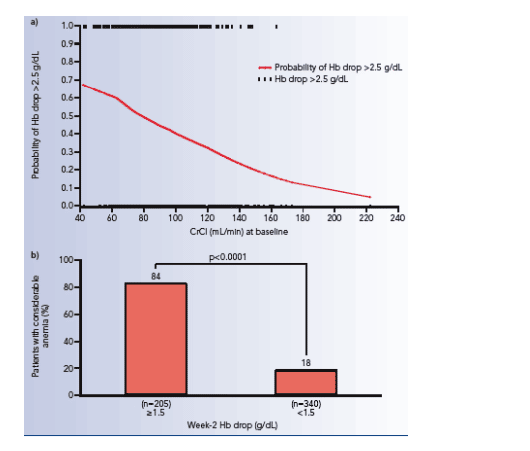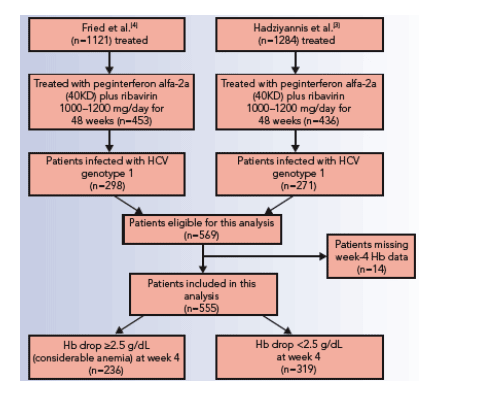 |
 |
 |
| |
Early predictors of anemia in patients with HCV genotype 1 treated with peginterferon alfa-2a (40KD) plus ribavirin 1000-1200 mg/day
|
| |
| |
Reported by Jules Levin
AASLD, Oct 27-31, 2006, Boston, MA
"...week 2 hemoglobin drop of 1.5 g/dL predicts anemia at week 4.....Considerable anemia at week 4 significantly correlated with more or earlier ribavirin dose reductions due to anemia (p<0.0001) and lower cumulative dose of ribavirin (p<0.001)...."
N. Reau,1 D. Jensen,1 S. Hadziyannis,2 D. Messinger,3 M. Fried4
1Center for Liver Diseases, University of Chicago Hospitals, Chicago, IL, USA; 2Henry Dunant Hospital, Athens, Greece; 3IST GmbH, Mannheim, Germany; 4University of North Carolina at Chapel Hill, NC, USA
INTRODUCTION
In patients infected with hepatitis C virus (HCV) genotype 1, pegylated interferon plus ribavirin daily for 48 weeks is the standard of care.[1]
However, ribavirin can be associated with an increased risk of dose-dependent hemolytic anemia.[2] In a randomized study of peginterferon alfa-2a (40KD) (PEGASYS) and ribavirin (COPEGUS) combination therapy, in which an overall sustained virological response (SVR) rate of 63% was achieved (52% in genotype 1 patients), hemoglobin levels of <10 g/dL were reported in up to 15.4% of patients.[3]
In a second study in which overall SVR rates of 56% were achieved, ribavirin dose reduction was required because of anemia in 22% of patients receiving combination therapy for 48 weeks.
Anemia-associated dose reduction of ribavirin may potentially affect the likelihood of an SVR, because dose adherence is critical in treatment of genotype 1 patients. Thus, the ability to predict which patients are likely to develop considerable anemia (defined as a decrease in hemoglobin of at least 2.5 g/dL from baseline) would allow early intervention to stabilize hemoglobin levels, and might allow patients to maintain a full dosing schedule.
OBJECTIVE
The objective of this analysis was to assess the baseline and on-treatment factors predictive of considerable anemia using data from studies with peginterferon alfa-2a (40KD) plus ribavirin 1000-1200 mg/day therapy in
patients infected with HCV genotype 1.
AUTHOR CONCLUSIONS
Important independent predictors of considerable anemia at week 4 associated
with peginterferon alfa-2a (40KD) (PEGASYS) plus ribavirin (COPEGUS) therapy were a week-2 hemoglobin drop of at least 1.5 g/dL, CrCl, non-Black/Asian race and cirrhosis. Although a trend towards a lower SVR rate was observed in patients with anemia compared with those without anemia, there was no significant difference in SVR rates achieved with peginterferon alfa-2a (40KD) plus ribavirin.
There were more ribavirin dose reductions and lower cumulative ribavirin doses
in patients with considerable anemia at week 4, which may have contributed to
slightly lower SVR rates in these patients. Stabilization of hemoglobin levels by use of early intervention therapies would allow these patients to continue on their full treatment schedule and potentially improve their chance of achieving an SVR.
Consistent with a previous report,[5] a reduction in hemoglobin level of at least 1.5 g/dL within the first 2 weeks of treatment may provide a clinically useful and direct means of predicting which patients are likely to experience considerable anemia at week 4, and therefore these patients could be identified as candidates for early intervention.
Figure 3. Association between considerable anemia (hemoglobin [Hb] drop >2.5 g/dL) at week 4 and a) CrCl (generalized additive model using smoothing splines with generalized cross validation) and b) week-2 Hb drop (<1.5 g/dL vs >1.5 g/dL).

METHODS
Patients and study design
Data from two pivotal, prospective, randomized, phase III trials in treatment-naive patients were pooled for the purpose of this analysis (Figure 1).[3,4] Only patients with HCV genotype 1 randomized to 48 weeks of treatment with peginterferon alfa-2a (40KD) and treated with standard-dose ribavirin were included.
The study design, methodology and the main findings of the studies have been published elsewhere.[3,4]
Assessments and statistical analysis
In total, 555 patients receiving at least one dose of study drug with week-2 and week-4 hemoglobin assessments were included in this analysis. Anemia assessments (serum hemoglobin) were carried out at baseline and either at weeks 1, 2, 4, 6, 8, and 12 and at 6-week intervals, thereafter,[3] or at baseline and at weeks 1, 2, 4, 6, and 8 and at monthly intervals thereafter, and at weeks 52, 60 and 72.[4]
Figure 1. Patients from the pivotal phase III studies who were included in the analysis and patients with and without considerable anemia at week 4.[3,4] Hb = hemoglobin.

In the original pivotal studies, the ribavirin dose was reduced to 600 mg/day if the hemoglobin level dropped to less than 10 g/dL in patients without heart disease or decreased by at least 2 g/dL in patients with stable heart disease. Ribavirin was discontinued in patients with hemoglobin levels less than 8.5 g/dL.
The SVR rates of patients (defined as undetectable serum HCV RNA [COBAS AMPLICORa HCV Test, v2.0; limit of detection <50 IU/mL] at the end of a 24-week follow-up period) with and without considerable anemia at week 4 were calculated.
The percentage of premature withdrawals, the percentage of patients with dose reductions due to anemia, the mean treatment duration, the cumulative dose and the average (weekly or daily) dose of peginterferon alfa-2a (40KD) and ribavirin were determined for patients with and without considerable anemia at week 4.
Univariate and multiple logistic regression (MLR) analyses were performed to analyze the predictive values of various baseline and on-treatment characteristics for considerable anemia at week 4.
- the characteristics considered were: HCV RNA titer, gender, race, age, bodyweight, body mass index, fibrosis/cirrhosis status, geographical region, hemoglobin, platelets, white blood cell count, creatinine, creatinine clearance (CrCl), ribavirin start dose per kg bodyweight, cumulative dose of ribavirin and peginterferon alfa-2a (40KD) per kg bodyweight in the first 4 weeks and week-2 hemoglobin reduction >1.5 g/dL from baseline.
In the stepwise model-building process, a variable was added if the adjusted chi-square statistic was significant at the 0.1 level and a variable was deleted if the Wald chi-square statistic was not significant at the 0.05 level. The functional association of continuous variables with considerable anemia was examined by generalized additive logistic regression models using generalized cross validation.
RESULTS
Of the 555 patients in this analysis, 236 (42.5%) patients exhibited considerable anemia (hemoglobin decrease >2.5 g/dL) at week 4.
The likelihood of an SVR in patients with considerable anemia at week 4 was slightly lower than that in patients without considerable anemia (47.5% vs 51.7%; p=0.3203), but did not reach statistical significance (Figure 2).
Eleven patients had missing data and were excluded from the MLR analysis.
The factors that were significantly and independently associated with considerable anemia at week 4 are presented in Table 1 (MLR analysis).
The most important baseline and early on-treatment predictive factors for considerable anemia at week 4 were a reduction in hemoglobin level of >/= 1.5 g/dL at week 2 and a low baseline CrCl, respectively.
The relationship between considerable anemia at week 4 and low baseline CrCl is shown in Figure 3a, and the proportion of patients with considerable anemia who experienced week-2 hemoglobin drops of more or less than 1.5 g/dL are presented in Figure 3b.
Considerable anemia at week 4 significantly correlated with more or earlier ribavirin dose reductions due to anemia (p<0.0001) and lower cumulative dose of ribavirin (p<0.001).
Table 1. Factors associated with considerable anemia at week 4 in 236 patients exhibiting a 32.5 g/dL decrease in hemoglobin


|
| |
|
 |
 |
|
|